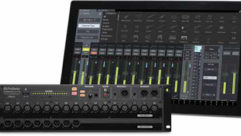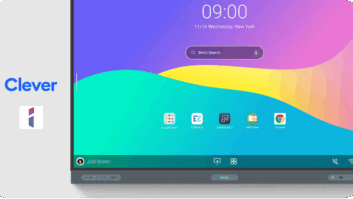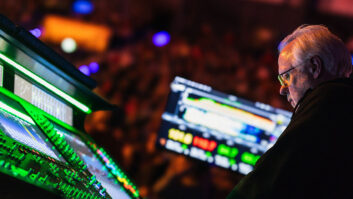THE MIRROR HAS TWO FACES
Jul 1, 2001 12:00 PM,
PETER H. PUTMAN, CTS
Texas Instruments rules the big screen market for now.
JVC phased out ILAs and switched its attention to the D-ILA, viewing it as the future of high-resolution, flat-matrix technology.
REGULAR READERS FOR THE PAST FIVE YEARS have tracked the ascension of Texas Instruments’ Digital Light Processing technology to the top of the heap in the electronic cinema and large-venue projection markets. Since its humble introduction at INFOCOMM 1995 in a 500-lumen nView desktop projector, DLP has won virtually the entire staging and rental market over to reflective imaging, while killing off large AM-LCD and hybrid (reflective LCD and CRT) projectors along the way.
TI’s efforts to showcase DLP technology in Hollywood have also paid off with the development of DLP Cinema, currently licensed on an exclusive basis to Barco, Digital Projection and Christie Digital Systems. DLP Cinema installations around the globe have premiered movies such as Tarzan, Dinosaur, Star Wars Episode I, and Mission to Mars.
This digital blitz has been so effective that many people who are hearing about electronic cinema for the first time have been effectively imprinted with the equation digital cinema = DLP.
What TI has accomplished with DLP technology is pretty impressive, especially when you consider that 1) DLP imaging first started out as a product for laser printers; and 2) the entire DLP program was nearly killed off completely by higher-ups at TI about five years ago, thanks to a substantial flow of red ink at the time.
Today, even though digital light processing is a small part of TI’s enormous digital signal processing semiconductor business, it remains one of the most effective ways to produce high-resolution images in portable projectors as well as xenon-lamp “big boxes.” It is even migrating into the consumer market via projection television sets from Mitsubishi, Panasonic and Hitachi.
THE DARK HORSE OF LIGHT IMAGING
TI’s impending domination of reflective projection technology might seem to be unchallenged except for a certain Japanese manufacturer of consumer and professional video equipment that stubbornly refuses to go down for the count. Japan Victor Corporation better known as JVC is holding ground with its liquid crystal on silicon imaging system and, in fact, may pose a competitive threat to TI in the electronic cinema market before too long.
JVC is not exactly new to the high-resolution projection business. Several years ago, it bought the assets of Hughes’ light-valve display division in Carlsbad, California and began manufacturing large (2-inch) amorphous LCD panels for use in a gargantuan projector known as the Image Light Amplifier. The first ILA I ever saw in action was at a small industry trade show in Chicago in 1994, and it was a beast, over 250 pounds with a big blower. But did it ever make bright, contrasty images!
The ILA was a regular fixture in the INFOCOMM Projection Shoot-Out for many years, and quite a few ILA projectors were used in installations for the military, staging and rental inventories, and even a prominent casino in Las Vegas (The Rio, where several 300-series ILA projectors still sit dormant in the largest theater).
Although the ILA could produce some beautiful images, it was a very high-maintenance projection system. It took a skilled technician some time to make the projector look as good as it did, and (depending on who you talked to) it had an annoying tendency to drift out of alignment.
In theory, the ILA could produce images with over 2000 lines of resolution. In reality, almost none of the customers for ILAs were screening images with that much detail, and a majority of them needed only XGA (1024 by 768) and occasionally SXGA (1280 by 1024). Given the far-simpler operation and faster setup of DLP projectors, the market voted with its feet and left the ILA to disappear into the mists of history.
LIKE A PHOENIX
But JVC wasn’t quite done yet. A few years back at Comdex, JVC unveiled a solid-state version of the ILA, using a smaller reflective LCoS device known as the Digital Image Light Amplifier, or D-ILA. At a time when manufacturers of conventional 1.3-inch transmissive polysilicon LCD projectors were just bringing XGA resolution to the market, JVC shocked everyone by showing a 0.9-inch device with true SXGA (1365 1024) resolution.
Not only that, they put three of them into a moderately sized installation projector with a xenon lamp and cranked out about 700 ANSI lumens. It wasn’t long before JVC quietly phased out production of large ILAs and switched its attention completely to the D-ILA, viewing it as the future of high-resolution, flat-matrix technology or at least one of the possible futures.
In the meantime, TI was building up momentum with DLP, unveiling smaller XGA DMDs (0.7-inch) and a functional SXGA device, followed by the “dark chip” used exclusively with DLP Cinema. JVC’s swan song with the ILA came during the electronic cinema demos during the summer of 1999, when Star Wars was screened on both systems in the New York and Los Angeles areas. Soon after, the ILA was never to be heard from again, and JVC quietly slipped from public awareness in the electronic cinema market.
That didn’t mean JVC was out of the game, though. At ShoWest 2001, the company once again got everyone’s attention with the demo of a QXGA (2048 1536) pixel D-ILA projector, delivering on its INFOCOMM 2000 promise. Simultaneously, JVC showed a 5000-lumen, large-venue projector (DLA-M5000U) suitable for many near-electronic cinema applications. This created a stir, indeed.
As this is being written, JVC is also testing a 4k 1k imaging system in Japan; and Kodak is hard at work developing its own cinema-grade D-ILA projector around the QXGA panels. JVC’s joint demo with Sony had many pepole abuzz about a possible alliance between the two companies. (Sony isn’t reluctant to put money into new imaging technology research and development. It has a controlling interest in the grating light-valve system developed by Silicon Light Machines, and has also invested heavily in laser color imaging.)
TI is by no means sitting back on its laurels, either. Although many TI representatives have told me that they consider JVC to be about 2 years behind TI in developing a high-quality e-cinema projection system, JVC is probably two years ahead of TI in terms of image resolution. After all, TI is first and foremost a semiconductor manufacturer and is just now getting sufficient deliveries of SXGA DMDs out to meet market demand.
BEHIND THE ACRONYMS
There are many industry observers who feel the high-resolution projector market will shift from transmissive to reflective imaging in the near future. Both the DLP and D-ILA products fall into this category, but couldn’t be more different in their concept and operation. So it’s an appropriate time to take a closer look at what makes each of these technologies work.
Digital Light Processing is a trademarked name for the imaging process that revolves around modulating the digital micromirror device mentioned earlier. The DMD is manufactured as a wafer process, just like integrated circuits. Each DMD contains thousands of tiny mirrors that each measure about 0.17 microns across, each secured to a center post.
When a switching voltage is applied to the mirror, the area under the post becomes charged, causing the mirror to tilt so that one corner is now touching a special land area. When the charge is reversed, the mirror tilts back to its original state. So, there are really only two positions for the mirror: on and off.
A powerful projection lamp emits light that is concentrated on the DMD’s surface. The “on” state reflects this light directly at the imaging lens, while “off” reflects all of the light away from the lens. Additional components in the projector provide a heat dump to safely dissipate the infrared energy from the lamp. (That reflected light has to go somewhere.)
How can a system that simple render grayscale images by simply turning on and off? Pulse-width modulation. If the mirror is flipped back and forth between on and off states at an extremely high rate of speed, a grayscale image can be created by varying the ratio of on-states to off-states within a specified time interval.
By having an equal ratio of on and off states within, say, one second, a mid-gray image is formed. Increase the on cycles, and the image gets brighter. Add off cycles, and the image becomes darker. Need color? You can use a single DMD with a special color wheel, which is synchronized to the operation of the DMD to produce red, green and blue light. Persistence of vision does the rest. Want high-quality saturated RGB color? Mount three DMDs precisely to a special splitting/integrating light prism, and use dichroic filters on each of the monochrome DMDs. With the images converged, the result is a full-color display with good grayscale reproduction. For best results, select a xenon arc lamp, just like those used in movie theaters.
At present, DLP is the only 100%-digital imaging system on the market. The mirrors in a DLP projector can actually run at speeds as low as 24 frames per second for electronic cinema. Or, they can switch at much faster rates (60, 72 and 75 Hz) for fast-refresh, high-resolution imaging. DMDs are manufactured in several sizes, including a 0.6-inch SVGA device, a 0.7-inch XGA version, and the 1.3-inch SXGA chip mentioned earlier.
Digital Image Light Amplifier is simply a fancy name for liquid crystal on silicon devices. Many other companies have started to manufacture LCoS devices, but none have had the production yields of JVC to date. The D-ILA in its basic form measures 0.9-inch diagonally, and was until recently only available in SXGA resolution.
It’s actually an LCD panel with an integrated circuit bonded to its back side. Polarized light from a projection lamp passes through the front surface of the D-ILA and is reflected from polished aluminum mirrored electrode surfaces on the IC/LCD substrate. Tiny nematic liquid-crystals within each pixel on the D-ILA shift their position. In fact, they literally twist into position in response to pixel-switching voltages.
The amount of twist in each pixel determines how much light will make it back out of that pixel, onto the integrating prism and projection lens. In effect, the D-ILA is functioning as a light shutter. With a pixel switched fully on, the arrangement (or twist) of the LCs in that pixel will block the light. A fully off state allows all of the light to pass through.
By varying the degree of twist in each pixel, grayscale images can be created. Once again, this is a monochromatic (black and white) imaging system, so color must be added with external color filters. In the D-ILA, this is typically done with three separate panels and dichroic mirrors, using a special integrating prism known as a polarized beam splitter to converge precisely the three images before they travel to the lens.
The D-ILA is a hybrid digital/analog imaging technology. The voltages used to switch the pixels are analog, as is the response of the LCs themselves. But the D-ILA can be directly addressed by a digital signal source such as SDI or HD-SDI. A D-ILA light engine for a large-venue projector is somewhat more complex than one using DMDs, although both require an integrating prism and separate dichroic mirrors.
D-ILA devices are presently not suitable for slow-frame projection of electronic cinema. To watch 24fps material, a D-ILA projector will generally refresh at two to three times that rate (48 to 72 Hz). Currently, there are no single-panel D-ILA projectors available, although JVC has experimented with a holographic color filter attached to a 16:9, 1.25-inch D-ILA for consumer use. The yields on this filter (not the panel) have been very low, and it will probably never see commercial production.
THE UPPER HAND
It’s hard to say which technology really has the upper hand. DLP does not require as complex an optical path; and, in fact, a single-chip DLP projector with color wheel is considered the clear winner as far as making a true microportable projection system. More light is recovered, and the efficiency of the projector is higher because the mirrors change light intensity by reflection angle.
In the D-ILA, light is traveling in two directions at once and therefore must be polarized, decreasing efficiency. A 3-chip DLP system is somewhat closer to the complexity of the 3-panel D-ILA system, although (again) the light path is still simpler in the DLP projector. There are no clear advantages in terms of color; both systems make use of high-quality dichroic mirrors and filters for RGB color.
Both systems have high aperture ratios, thanks to the absence of switching electronics on their front surfaces. For the DMD, the effective aperture ratio is currently about 91%, while it’s 93% on the D-ILA. Pixel density is greater on the D-ILA, with a typical pitch of 0.7 microns vs. the DMD’s 17 microns.
Both systems can have excellent contrast, but only TI and its partners have demonstrated images with both high contrast and deep black levels. That’s because they’ve had much more time to make the process work. Indeed, some demonstrations of DLP Cinema are producing black levels comparable to virgin answer prints, and more and more naysayers are giving DLP Cinema a second look.
If the D-ILA has an edge, it’s in available resolution. Considering that JVC started at 1365 by 1024 pixels, there is a lot of room to go up in resolution, as well as room to make the devices smaller. JVC has already shown a 0.7-inch SXGA+ (1400 by 1050) D-ILA, a size in which only 1024 768 (XGA) resolution is currently available from transmissive polysilicon LCDs and DMDs.
The new QXGA device is about the same size as TI’s SXGA chip (1.3 inches), and both work well with 35mm projectors’ optical components. That alone has the folks at TI looking very carefully at JVC’s progress. Plus, there was the announcement at last year’s INFOCOMM that JVC was willing and ready to sell D-ILA panels to whoever wants to buy ’em.
For those “show me” types in the motion picture industry, the news of an electronic imaging system with 2K native resolution has more than passing interest. Several experts consider 2000 lines to be the effective resolution of a 35mm-release print on a correctly operating film projector, and it’s also the working resolution for film-to-digital transfers.
Those hard-working souls in the compositing departments of many post houses would have no objections to higher-resolution projection systems in their day-to-day work. It’s nice to be able to see as many pixels as possible! For other screening purposes, having native 2K resolution means you don’t always need an anamorphic lens. Simple letterboxing will achieve over 1100 vertical pixels of resolution with a 1.85:1 source, and nearly 900 pixels when screening CinemaScope material.
NEW WORLDS TO CONQUER
Both TI and JVC have set their sights on other markets, the biggest being consumer TVs. While Mitsubishi, Panasonic and Hitachi all have specially developed 1280 720 (16:9) versions of the DMD for high-end RPTVs (and Sharp’s XV-9000U front projector), a recent announcement by Texas Instruments confirmed that an SDTV version (848 by 480 pixels, or Wide VGA) would be available for lower-cost RPTVs and projectors to be sold by partners InFocus and PLUS.
JVC has similar plans in mind. Its current timetable calls for the introduction of a 0.5-inch, 1280 720, 16:9 device for similar consumer applications (the current D’Ahlia RPTV uses a 1.35-inch, 1280 1028 device with non-square pixels). There’s also a UXGA (1600 1200), 0.9-inch device in the works, although the market for that kind of imaging still has to be fleshed out.
For now, TI components hold the upper hand. There are several manufacturers of DLP projectors, and the technology is well enough understood to be dependable for providing good image quality. While JVC is still getting the highest yields from its D-ILA line of any LCoS manufacturer, it still needs to put more work into projector engineering to get to the performance levels of DLP cinema.
Will JVC get there? Apparently Kodak thinks so, as it has begun prototyping of its own cinema-grade D-ILA projector. Sony, one of the earliest adopters of DLP technology, has been very quiet about the whole process. Although Sony does have a 3-chip, high-brightness DLP projector (VP-LE100), it’s not being sold in very large quantities. Perhaps Sony is looking to reflective LCDs as the electronic cinema platform of the future. One never knows.
No doubt there will have been more announcements about both systems at INFOCOMM 2001, which will be over by the time you read this. Look for JVC to provide a more specific shipping date for the DLA-QX1 7000-lumen QXGA projector shown at ShoWest, and there may even be a demo of a D-ILA box in other booths. It’s going to be an interesting horse race!
Peter H. Putman owns PHP Communications, Doylestown, Pennsylvania. He is author of The Toastmasters Guide to Audio/Visual Presentations and reviews large-screen displays and computer/video interfaces.









